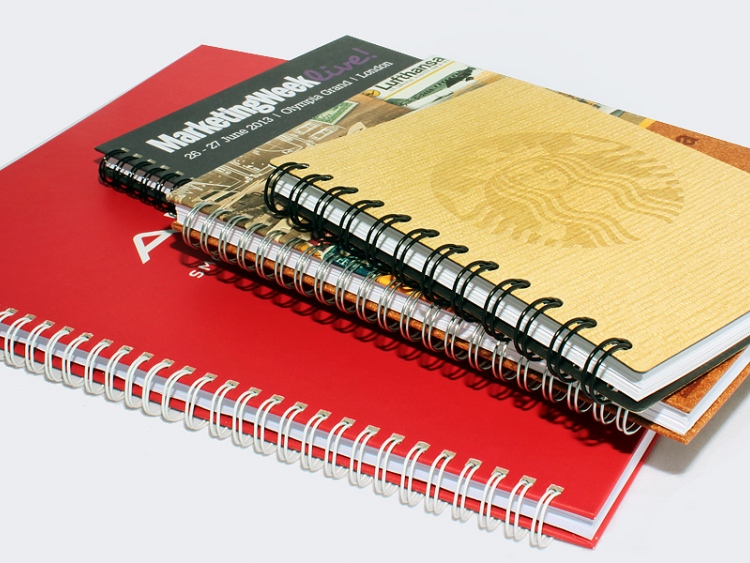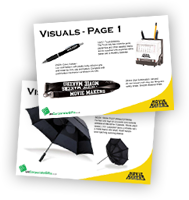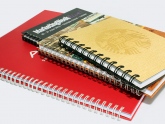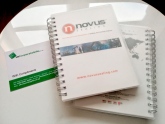
Corporate Notebooks: A Style Guide
Corporate notebooks are brilliant branded gifts, as their wide, flat surface area allows them to proudly display your logo. But there are lots of corporate noteboks to choose from, so which should you go for? This article explains the different options in terms of size, materials and page design - to help you decide which design is right for your brand.
Corporate Notebook Sizes
Corporate notebooks come in A4, A5 and A6 sizes. They also come in other, irregular sizes, like pocket, square and mini. A4 notebooks are ideal for educational promotions by a school or university, whilst pocket notebooks would make compact, practical giveaways for an online shop or retailer.
 Think about what your clients will be using their notebooks for, before choosing a size
Think about what your clients will be using their notebooks for, before choosing a size
Because larger notebooks tend to be used for more serious notetaking, branding should be kept unobtrusive and subtle. Meanwhile, smaller notebooks can be branded with bright colours and wacky designs, as they are more likely to be used for shopping lists and other everyday tasks.
Corporate Notebook Covers
There are lots of different types of promotional notebook covers, all with their own unique advantages.
1. Card
Card is an affordable material that is suited to small notebooks which don't need to be particularly long-lasting. It comes in a range of colours.

Card covered notebooks can look minimalist and stylish when branded simply
2. Laminated Card
Laminated card has a gloss or silk finish and an eye-catching look. It is more durable than regular card as dirt and moisture can easily be wiped clean. If you want to show off your brand's green credentials, you can also choose recycled card.
 The benefit of laminated card is that the glossy effect really makes your artwork stand out
The benefit of laminated card is that the glossy effect really makes your artwork stand out
3. Plastic
Polypropylene is a kind of plastic that is stiff and durable, so notebooks made from this will last for a long time. It comes in a range of colours that can be opaque or frosted. Printing can go directly onto the cover, or you could add full colour artwork on the first page, that will be visible through a transparen cover.
 This polypropylene cover is frosted, so you can see through it
This polypropylene cover is frosted, so you can see through it
4.Soft-feel
Polyurethane is a padded soft-feel material that will give your notebook a more luxurious feel. This makes it an excellent material for notebooks that will be used for a long time, such as A4 workbooks and diaries.
 Soft-feel covers are suited to small or pocket-sized notebooks, as they are more comfortable to carry around
Soft-feel covers are suited to small or pocket-sized notebooks, as they are more comfortable to carry around
5. Leather
Leather is one of the most high-end materials available for corporate notebooks. It is ideal for heritage brands and for notebooks that are going to be used as gifts for loyal customers.

5. Faux Leather
Faux leather is a brilliant option if you want to present your brand as sophisticated and upmarket, but don't quite have the budget for leather.
 Faux leather is almost indistinguishable from real leather, but comes without the heavy pricetag
Faux leather is almost indistinguishable from real leather, but comes without the heavy pricetag
6. Textured Paper
The paper used on your cover can have a range of textures that mimic other materials, like croc finish leather, wood or fabric.
 This notebook has a textured paper cover that looks stylish and high value, but without the price tag.
This notebook has a textured paper cover that looks stylish and high value, but without the price tag.
7. Bamboo
Bamboo looks beautiful and natural, and is a sustainable material, so works well if you are an eco-friendly business.
 Because it's a hard material, bamboo notebooks can be sturdier and longer-lasting than other kinds
Because it's a hard material, bamboo notebooks can be sturdier and longer-lasting than other kinds
Corporate Notebooks Branding Options
Corporate notebooks can be branded in a wide range of ways, including printing, embossing or foilblocking. There are also some less well known methods - all shown below.
1. Embossing
Embossing creates either a raised or indented design on the notebook cover. It gives your product a more subtle, understated look.
 When the design is sunken into the surface, the technical term is actually debossing
When the design is sunken into the surface, the technical term is actually debossing
2. Foil Blocking
Coloured foil is stamped onto the notebook cover for a shimmery design that stands out.
 Foilblocking is usually done with silver or gold foil, but other colours are available
Foilblocking is usually done with silver or gold foil, but other colours are available
3. Spot Colour Printing
Spot colour printing is where block colours are printed separately on the notebook cover. Gradients and shadows can't be achieved using this method, so it is best if you want a minimalist, simple design.
 You can print more than one colour using spot-colour printing, but the fewer colours you use the cheaper it will be
You can print more than one colour using spot-colour printing, but the fewer colours you use the cheaper it will be
4. Full Colour Printing
Your logo can be reproduced exactly as it is with full-colour printing, including gradients, shadows and photos.
 Full colour print allows for adding images to your cover
Full colour print allows for adding images to your cover
5. Cut-Outs
You can have shapes cut out of your notebook's cover to reveal a design on the page underneath.
 This way of branding gives an extra dimension to your notebooks that will make that bit more original and eye-catching
This way of branding gives an extra dimension to your notebooks that will make that bit more original and eye-catching
7. Embedding
Embedding is where the shape of your logo is cut out of the cover, and then filled in with another material. The "live!" graphic has been die cut out of a separate piece of board and fitted into the cover, giving it a three-dimensional look
The "live!" graphic has been die cut out of a separate piece of board and fitted into the cover, giving it a three-dimensional look
8. Burnt-out Look
Your logo or graphic can be het-pressed into a textured board, biving it a darker look and a subtle finish.
 The words on the cover of this notebook have been branded using the burnt-out method
The words on the cover of this notebook have been branded using the burnt-out method
9. UV Spot Colour Printing
A special clear film can be applied to parts of the artwork to make it appear shiny as it reflects light. This methot is called UV Spot Printing.
 The logo in the centre of the notebook cover has a UV film applied to make it stand out against the burnt out design on the textured board
The logo in the centre of the notebook cover has a UV film applied to make it stand out against the burnt out design on the textured board
Corporate Notebook Binding
There are three main types of binding for notebooks: spiral, casebind and stapling. Spiral binding is usually silver, white or black in colour, and allows for pages to be torn from a notebook easily. Casebinding is only used on hardcover notebooks and it will ensure they last a long time. Stapling, or staple stitching, allows a small number of sheets to be stitched to the cover of a notebook, so is used for exercise books, manuals and booklets.
 Here you can see all three binding types and the types of books they're used for
Here you can see all three binding types and the types of books they're used for
Corporate Notebook Pages
The insides of your notebooks are customisable as well! You can have lined, plain or squared paper, depending on what you intend your notebooks to be used for. You can also have artwork printed on the inside, and have custom advertising pages included.
 A notebook with gridded or squared pages could be used by maths or science students
A notebook with gridded or squared pages could be used by maths or science students
If you would like more information about any of the different types of notebook or the branding options in this article, please feel free to give us a ring on 01204 577 995. Or, take a look at our website to see more detailled info on each of the notebooks in our range.
Talk to Us
»
01204 577 995
info@UKCorporateGifts.co.uk











